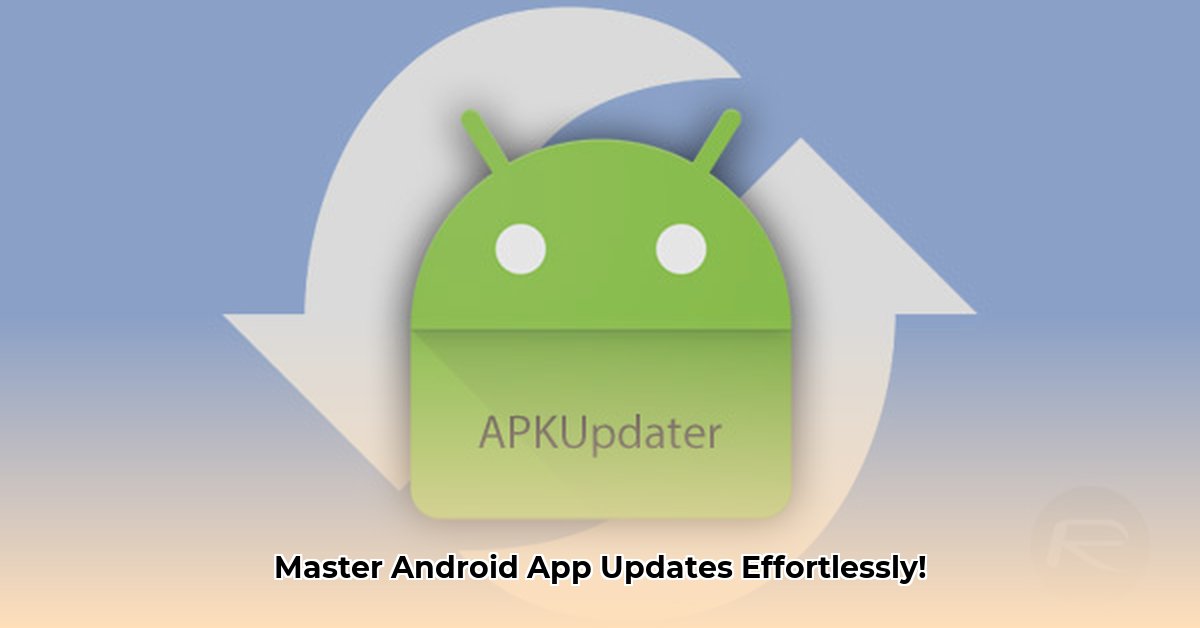
Keeping your Android apps updated shouldn't be a chore. Yet, navigating the options—from Android's built-in system to third-party apps like Software Updater—can be confusing. This guide clarifies the process, outlining the pros and cons of each approach, and offering actionable advice for seamless and secure app updates.
Choosing Your Update Method: Native vs. Third-Party
Tired of sporadic update notifications and the risk of outdated apps? Many Android users grapple with efficient app update management. This guide helps you choose the best method for your needs. Let's examine the strengths and weaknesses of native and third-party app update solutions.
Android's Built-in Update System: Simple Yet Limited
Android's built-in update functionality, managed via the Google Play Store, is designed for straightforward app updates. It automatically checks for updates and notifies you when they're available. You can also manually check for updates within the Play Store app. However, this simplicity has drawbacks. Updates may be infrequent, potentially leaving your apps vulnerable to bugs or security risks. Additionally, you lack granular control over the timing of updates.
To optimize the native system, ensure you have a stable internet connection and a regularly updated Play Store app. Enabling automatic updates in your Play Store settings helps prevent you from missing critical security patches, but be aware this can increase data usage. Does automatic updating consume too much data on your plan? Consider manually checking for updates regularly.
Third-Party Update Apps: Enhanced Control but Increased Risk
Third-party software updater APKs (Android Package Kits) offer a more proactive approach to managing app updates. They often provide features like scheduled updates, pre-update backups, and a consolidated view of all your app updates. However, using these apps introduces potential risks.
Weighing the Pros and Cons
Pros:
- Streamlined Updates: Schedule updates to avoid interruptions. Many apps automatically back up your data before updates, minimizing data loss risks.
- User-Friendly Interfaces: These apps often provide a more intuitive and streamlined experience compared to the standard Play Store update mechanism.
- Extra Features: Some apps offer additional features like data backup and restoration, simplifying app management.
Cons:
- Potential Conflicts: A poorly designed third-party app could clash with your phone's OEM (Original Equipment Manufacturer) system, leading to unexpected issues.
- Security Concerns: Using third-party apps introduces security risks. You rely on the developer's security practices, and a compromised app could expose your data.
- Excessive Permissions: Some apps may request excessive permissions, raising privacy concerns. Always carefully review requested permissions before installation.
Choosing Safely: Download third-party software updater APKs only from reputable sources like the Google Play Store. Always carefully review app permissions and user reviews before installation to mitigate potential security and privacy risks. Remember, convenience should never compromise security.
Head-to-Head: A Comparative Analysis
The following table contrasts native and third-party update methods:
| Feature | Native Android Updates (Google Play) | Third-Party Update Apps |
|---|---|---|
| Ease of Use | Simple | More Convenient |
| Security | High | Variable |
| Features | Basic | Advanced (potential) |
| Potential Issues | Infrequent Updates, Limited Control | Compatibility Issues, Security Risks |
Mastering Android App Updates: Best Practices
Regardless of your chosen update method, these best practices ensure smooth and secure app updates:
- Regular Data Backups: Regularly back up your data to the cloud or your computer. This safeguards against data loss during updates.
- Reputable Sources Only: Download apps exclusively from trusted sources like the Google Play Store.
- Permission Scrutiny: Carefully review requested permissions before installing any app, especially third-party updaters.
- Operating System Updates: Keep your Android OS up-to-date. OS updates often include vital security patches.
- Read User Reviews: Always check user reviews before installing a third-party app to identify potential issues.
The Evolving Landscape of App Updates
The future of app updates points towards AI-driven optimization for smarter, more efficient updates. Future systems might predict optimal update times, minimizing battery drain and maximizing uptime. The ultimate goal is seamless and hassle-free app updates.
Key Takeaways: A Summary of Best Practices
- Understanding your devices update mechanism is crucial for smooth operation. This is true whether you utilize Google Play's built-in tools or third-party applications.
- Google Play's built-in features offer control but have limitations. Users must actively check for updates and address any potential delays.
- Third-party updater apps offer more features but introduce risks. Due diligence, including permission checks and source verification, is essential.
By following these guidelines, you can ensure your Android apps remain updated without compromising your device's security or performance.
⭐⭐⭐⭐☆ (4.8)
Download via Link 1
Download via Link 2
Last updated: Wednesday, May 14, 2025